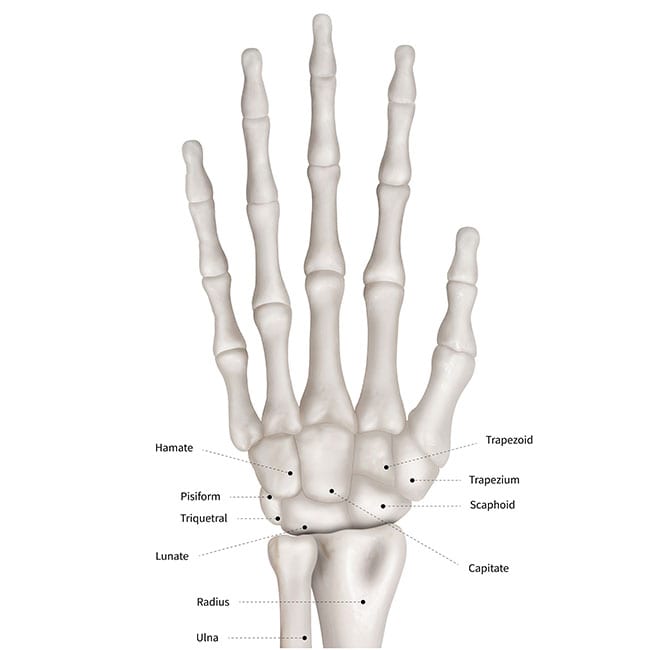
Do I have a Broken or Sprained Wrist?
We’ve all been there—rushing around, juggling too many things at once, when suddenly, we trip and fall. Most of the time, we get up, dust ourselves off, and move on. But instinctively, we put our hands out to catch ourselves, and that’s where trouble can start. Our wrists aren’t built to absorb that kind of impact, and the force of a fall can easily lead to injury.
Wrist pain after a fall might mean a broken or sprained wrist, but how can you tell the difference? Sometimes, it’s not so obvious.
In today’s post, I’ll break down what a wrist fracture is, how to distinguish between a fracture and a sprain, and what treatment options are available.
Understanding the Wrist

The wrist is made up of the ends of the radius and ulna, 8 carpal bones, and the bases of the 5 metacarpal bones.
Types of wrist fractures (or breaks)
A fracture and a break are considered the same thing. A wrist fracture is when one or more bones in the wrist break. Below are the most common type of wrist fractures:

The scaphoid carpal bone is just below the base of thumb and can be broken when you fall on an outstretched palm and wrist. This bone is the second most common one to be fractured. An unrecognized fracture of the scaphoid bone is often mistaken for a wrist sprain as the swelling is usually only located to the small area where the bone is, and motion of the wrist can be maintained. Other carpal bones can be fractures but are much less common.
"You should not assume that the degree of pain determines the specific problem. Although it would seem that a sprain would hurt less than a fracture, this is not always the case. "Brandon P. Donnelly, MD
The Difference Between a Broken or Sprained Wrist
A sprain involves the ligaments that connect the bones at the joint. It can be difficult to tell the difference between a fracture and a sprain. You should not assume that the degree of pain determines the specific problem.
Although it would seem that a sprain would hurt less than a fracture, this is not always the case. Sprains can often be extremely painful, where fractures may sometimes hurt less. There are also different degrees of sprains from mild to severe.
A broken or sprained wrist may have many of the same symptoms:
However, if you’ve fractured your wrist, there are a few symptoms that go beyond sprains. There may be a deformity in the wrist and bone pushing against the skin or sometimes puncturing it. When you fall and hurt your wrists, you might hear a snap or pop and your wrist will usually swell immediately and worsen, even when treated with ice.
The best way to know for certain if your wrist is fractured or sprained is to see a hand surgery specialist. They can do a thorough assessment and diagnose what is causing your pain.
"Many wrist fractures do not require surgery, and can be adequately treated in a cast or brace. "Brandon P. Donnelly, MD
Treatment for a Broken Wrist
If you believe you’ve sprained your wrist, you should treat it with ice, stabilize it with a brace or splint, and keep it elevated. Nevertheless, if you’re concerned that you may have fractured it or the pain and swelling intensifies, apply ice, and then see a hand specialist as soon as possible.
Many wrist fractures do not require surgery, and can adequately treated in a cast or brace. Sometimes it does require the bones to be “set” or put back in alignment. Open surgery is usually reserved for fractures with significant displacement, or recurrent displacement after attempted reduction and immobilization.
Don’t Ignore Wrist Injuries
Wrist fractures, like essentially all broken bones are best treated when treated early. This may be as simple and putting a brace on, which will immobilize and protect the bone easing the pain and preventing displacement.
Some fractures, like the scaphoid fracture, have poor outcomes when treated late. Due to its unique blood supply, scaphoid fractures have higher risk of non-healing or nonunion than other wrist bones. When this bone does not heal, it will, overtime, develop a predictable pattern of wrist arthritis.
How to Prevent a Broken or Sprained Wrist
My best advice--try not to fall! This may seem common sense, but many times the cause is preventable. Loose rugs, items on the floor, unsafe ladder use, all are preventable common causes of falls. As much as we love our pets, we must also be careful with them around our feet as well.
Second to that, there are a few things you can do to prevent a wrist injury should you fall.
Think You have a Broken of Sprained Wrist?
If you suspect you have fractured your wrist, schedule an appointment for an evaluation. Dr. Donnelly can accurately diagnose your pain and treat your injured wrist quickly and effectively.
This site is not intended to and does not provide medical advice, professional diagnosis, opinion, treatment or services to you or to any other individual. Through this website and links to other websites, Brandon P. Donnelly, MD provides general information for educational purposes only. The content provided in this website and links, is not a substitute for medical care or treatment. You should not use this information in place of a consultation or the advice of your healthcare provider. Brandon P. Donnelly, MD is not liable or responsible for any advice, course of treatment, diagnosis or any other information, services or product you obtain through this site.

